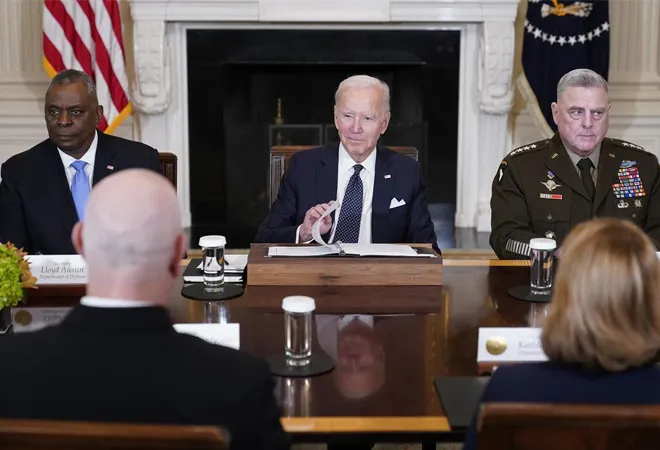The United States has
launched its much anticipated National Security Strategy (NSS). All U.S. Presidents are mandated by the
Goldwater-Nichols Department of Defense Reorganization Act of 1986 to bring out their NSS, to communicate the executive’s vision of national security to the legislative. As a comprehensive document, the NSS reflects certainty about how the government of the day views the national security agenda. Alternatively, the NSS also gives the Congress an opportunity to assess the cost that the country will have to bear and the areas of investments to achieve the nation’s security goals.
Focus on leadership and alliances
The Biden administration’s NSS primarily focuses on the current decade as a ‘decisive’ one in which the U.S. seeks to sustain U.S. leadership, improve the U.S. economy, build on a vast network of alliances and partnerships; counter China as its strategic competitor and Russia as a disruptor, and boost U.S. competitiveness and defend democracy. The document portrays the ambitious agenda of the Biden administration to cover a comprehensive set of transnational challenges tying the domestic with the international. These include climate change, food insecurity, pandemics, terrorism, energy shortages and inflation. Besides, the administration’s NSS has considerable focus on outer space security and governance.
The document portrays the ambitious agenda of the Biden administration to cover a comprehensive set of transnational challenges tying the domestic with the international.
The NSS lays down three main fulcrums of U.S. strategy going forward: invest; build and modernise. It seeks to invest in the “tools of American power and influence” by strengthening the economy at home, improving critical infrastructure and investing in technologies such as microchips and semiconductors. Consistent with this approach, effective October 12, the Biden administration has imposed a slew of sanctions impacting the U.S. sale of semiconductors to China as well as the ability of U.S. citizens and residents to work in chip companies in China. Furthermore, the NSS seeks to build ‘the strongest possible coalition of nations’ — a recognition of both the U.S.’s ambitions as well as limitations in driving global geopolitics unilaterally. Finally, the modernisation sought by the U.S. is intended to cater to the wide-ranging demands of internal and external security, simultaneously. These capability enhancements underscore the recognition by the U.S. of the unprecedented scale and scope of strategic competition with China. It names China as the ‘only competitor’ with the capability and intent to shape the international order in a fundamental way.
Outcompeting China, restraining Russia
The NSS takes both a long-term and an immediate view of the China threat and the challenges emerging from Beijing. While it seeks to outline a joint strategy to tackle external challenges for the U.S. by out-competing China and constraining Russia, it is asymmetrically tilted in its focus on threats from China despite an active war in which Russia is involved. The Biden administration places competition with China at the centre of its decadal outlook, which is increasingly global in character and most pronounced in the Indo-Pacific region across a range of domains such as the economy, technology, development, security, global governance and diplomacy. The NSS is clear about the opposition to any unilateral change to Taiwan’s status by China, portending a contested Indo-Pacific region between China on one hand and a host of democratic partners on the other. Therefore, forging collective capacity through international partnerships and creating new alliances for tackling shared challenges lie at the heart of the NSS. This also forms an essential strategy for the U.S. to synchronously compete with China, constrain Russia, tackle non-traditional threats and transnational challenges such as climate change, communicable diseases, food security and inflation. The NSS makes a serious case for downgraded Russian economy, military, soft power and influence globally, even as it identifies countries such as Japan and India to fill the emerging gaps. One such process at which the NSS hints is India’s possible integration in important global forums such as the G7. Here, some of the expectations in the NSS reflect the U.S. interests purely and may not be entirely in sync with those of its other Indo-Pacific partners.
The Biden administration places competition with China at the centre of its decadal outlook, which is increasingly global in character and most pronounced in the Indo-Pacific region across a range of domains such as the economy, technology, development, security, global governance and diplomacy.
India as partner
The Biden administration’s NSS identifies India as both a bilateral and multilateral partner in the Indo-Pacific, but, more importantly, its status as the largest democracy and a major defence partner. As India looks to diversify and indigenise its defence needs in the medium and long term, the NSS lays out the space for partnership between India and the U.S. India’s partnership in the Indo-Pacific has been assessed as critical in building a “latticework of strong, resilient and mutually reinforcing relationships” through regional partnerships such as the Quad (India, Australia, Japan, the U.S.) and the I2U2 (India, Israel, the United Arab Emirates, and the U.S).
This commentaty originally appeared in The Hindu.
The views expressed above belong to the author(s). ORF research and analyses now available on Telegram! Click here to access our curated content — blogs, longforms and interviews.


